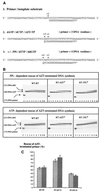The M184V mutation in the reverse transcriptase of human immunodeficiency virus type 1 impairs rescue of chain-terminated DNA synthesis
- PMID: 10729133
- PMCID: PMC111867
- DOI: 10.1128/jvi.74.8.3579-3585.2000
The M184V mutation in the reverse transcriptase of human immunodeficiency virus type 1 impairs rescue of chain-terminated DNA synthesis
Abstract
Nucleoside analog chain terminators such as 3'-azido-3'-deoxythymidine (AZT) and 2',3'-dideoxy-3'-thiacytidine (3TC) represent an important class of drugs that are used in the clinic to inhibit the reverse transcriptase (RT) of human immunodeficiency virus type 1. Recent data have suggested that mutant enzymes associated with AZT resistance are capable of removing the chain-terminating residue with much greater efficiency than wild-type RT and this may, in turn, facilitate rescue of DNA synthesis; these experiments were performed using physiological concentrations of pyrophosphate or nucleoside triphosphates, respectively. The present study demonstrates that the M184V mutation, which confers high-level resistance to 3TC, can severely compromise the removal of chain-terminating nucleotides. Pyrophosphorolysis on 3TC-terminated primer strands was not detectable with M184V-containing, as opposed to wild-type, RT, and rescue of AZT-terminated DNA synthesis was significantly decreased with the former enzyme. Thus, mutated RTs associated with resistance to AZT and 3TC possess opposing, and therefore incompatible, phenotypes in this regard. These results are consistent with tissue culture and clinical data showing sustained antiviral effects of AZT in the context of viruses that contain the M184V mutation in the RT-encoding gene.
Figures





Similar articles
-
The M184V mutation reduces the selective excision of zidovudine 5'-monophosphate (AZTMP) by the reverse transcriptase of human immunodeficiency virus type 1.J Virol. 2002 Apr;76(7):3248-56. doi: 10.1128/jvi.76.7.3248-3256.2002. J Virol. 2002. PMID: 11884549 Free PMC article.
-
The L74V mutation in human immunodeficiency virus type 1 reverse transcriptase counteracts enhanced excision of zidovudine monophosphate associated with thymidine analog resistance mutations.Antimicrob Agents Chemother. 2005 Jul;49(7):2648-56. doi: 10.1128/AAC.49.7.2648-2656.2005. Antimicrob Agents Chemother. 2005. PMID: 15980332 Free PMC article.
-
Single-step kinetics of HIV-1 reverse transcriptase mutants responsible for virus resistance to nucleoside inhibitors zidovudine and 3-TC.Biochemistry. 1997 Aug 19;36(33):10292-300. doi: 10.1021/bi970512z. Biochemistry. 1997. PMID: 9254628
-
Mutational patterns in the HIV genome and cross-resistance following nucleoside and nucleotide analogue drug exposure.Antivir Ther. 2001;6 Suppl 3:25-44. Antivir Ther. 2001. PMID: 11678471 Review.
-
Perspectives on the molecular mechanism of inhibition and toxicity of nucleoside analogs that target HIV-1 reverse transcriptase.Biochim Biophys Acta. 2002 Jul 18;1587(2-3):296-9. doi: 10.1016/s0925-4439(02)00092-3. Biochim Biophys Acta. 2002. PMID: 12084471 Review.
Cited by
-
Hypersusceptibility mechanism of Tenofovir-resistant HIV to EFdA.Retrovirology. 2013 Jun 24;10:65. doi: 10.1186/1742-4690-10-65. Retrovirology. 2013. PMID: 23800377 Free PMC article.
-
The level of reverse transcriptase (RT) in human immunodeficiency virus type 1 particles affects susceptibility to nonnucleoside RT inhibitors but not to lamivudine.J Virol. 2006 Mar;80(5):2578-81. doi: 10.1128/JVI.80.5.2578-2581.2006. J Virol. 2006. PMID: 16474164 Free PMC article.
-
Two proton transfers in the transition state for nucleotidyl transfer catalyzed by RNA- and DNA-dependent RNA and DNA polymerases.Proc Natl Acad Sci U S A. 2007 Mar 13;104(11):4267-72. doi: 10.1073/pnas.0608952104. Epub 2007 Mar 5. Proc Natl Acad Sci U S A. 2007. PMID: 17360513 Free PMC article.
-
The Genetic Basis of HIV-1 Resistance to Reverse Transcriptase and Protease Inhibitors.AIDS Rev. 2000;2(4):211-228. AIDS Rev. 2000. PMID: 19096725 Free PMC article.
-
Resistance to reverse transcriptase inhibitors used in the treatment and prevention of HIV-1 infection.Future Microbiol. 2015;10(11):1773-82. doi: 10.2217/fmb.15.106. Epub 2015 Oct 30. Future Microbiol. 2015. PMID: 26517190 Free PMC article. Review.
References
-
- Arion D, Kausshik N, McCormick S, Borkow G, Parniak M A. Phenotypic mechanism of HIV-1 resistance to 3′-azido-3′-deoxythymidine (AZT): increased polymerization processivity and enhanced sensitivity to pyrophosphate of the mutant viral reverse transcriptase. Biochemistry. 1998;37:15908–15917. - PubMed
-
- Boucher C A B, Cammack N, Schipper P, Schuurman R, Rouse P, Wainberg M A, Cameron J M. High level resistance to (−) enantiomeric 2′-deoxy-3′-thiacytidine in vitro is due to one amino acid substitution in the catalytic site of human immunodeficiency virus type 1 reverse transcriptase. Antimicrob Agents Chemother. 1993;37:2231–2234. - PMC - PubMed
-
- Canard B, Sarfati S R, Richardson C C. Enhanced binding of azidothymidine-resistant human immunodeficiency virus 1 reverse transcriptase to the 3′-azido-3′-deoxythymidine 5′-mono-phosphate-terminated primer. J Biol Chem. 1998;273:14596–14604. - PubMed
Publication types
MeSH terms
Substances
LinkOut - more resources
Full Text Sources
Other Literature Sources

